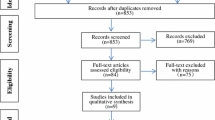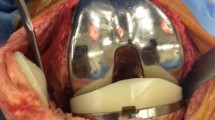Abstract
Purpose
Recently, the Persona total knee arthroplasty (TKA) system with more anatomical features and a similarly high flexion to the previous version, LPS-Flex, was introduced and is widely used. This study aimed to compare the early outcomes obtained using Persona versus an LPS-Flex fixed PS implant.
Methods
A total of 784 knees that underwent primary TKAs (162: Persona group and 622: LPS-Flex group) were included. After 1:2 propensity score matching, there were 143 and 286 knees in Persona and LPS-Flex groups, respectively. Range of motion at the 2-year follow-up was the primary variable. Secondary variables were functional score, ability to perform activities requiring deep knee flexion, patient satisfaction, and radiographic measurements, including radiolucent line (RLL).
Results
The average postoperative maximal flexion measured by goniometer at 2 years after TKA was 126.1° ± 10.8° (range 95°–140°) for the Persona group and 132.7° ± 11.7° (range 103°–145°) for the LPS-Flex group (P < 0.05). This significant difference was observed from 1 year postoperatively (P < 0.05). The two groups did not show a significant difference in functional score, postoperative ability in high flexion activities, and satisfaction at the 2-year follow-up. The rate of RLL was significantly lower in the Persona group (P < 0.05).
Conclusion
At the 2-year follow-up, the Persona group had less maximal flexion; however, the difference in flexion did not seem to affect clinical outcomes. According to the radiological results, the Persona system shows less RLL than does the LPS-Flex system.
Level of evidence
III.





Similar content being viewed by others
References
Anouchi YS, McShane M, Kelly F Jr, Elting J, Stiehl J (1996) Range of motion in total knee replacement. Clin Orthop Relat Res 331:87–92
Bauman RD, Johnson DR, Menge TJ, Kim RH, Dennis DA (2012) Can a high-flexion total knee arthroplasty relieve pain and restore function without premature failure? Clin Orthop Relat Res 470:150–158
Bellamy N, Buchanan WW, Goldsmith CH, Campbell J, Stitt LW (1988) Validation study of WOMAC: a health status instrument for measuring clinically important patient relevant outcomes to antirheumatic drug therapy in patients with osteoarthritis of the hip or knee. J Rheumatol 15:1833–1840
Bellemans J, Banks S, Victor J, Vandenneucker H, Moemans A (2002) Fluoroscopic analysis of the kinematics of deep flexion in total knee arthroplasty: influence of posterior condylar offset. J Bone Jt Surg Br 84:50–53
Cho S-D, Youm Y-S, Park K-B (2011) Three-to six-year follow-up results after high-flexion total knee arthroplasty: can we allow passive deep knee bending? Knee Surg Sports Traumatol Arthrosc 19:899–903
Dai Y, Scuderi GR, Penninger C, Bischoff JE, Rosenberg A (2014) Increased shape and size offerings of femoral components improve fit during total knee arthroplasty. Knee Surg Sports Traumatol Arthrosc 22:2931–2940
Devers BN, Conditt MA, Jamieson ML, Driscoll MD, Noble PC, Parsley BS (2011) Does greater knee flexion increase patient function and satisfaction after total knee arthroplasty? J Arthroplast 26:178–186
Edwards JZ, Greene KA, Davis RS, Kovacik MW, Noe DA, Askew MJ (2004) Measuring flexion in knee arthroplasty patients. J Arthroplast 19:369–372
Ewald FC (1989) The Knee Society total knee arthroplasty roentgenographic evaluation and scoring system. Clin Orthop Relat Res 248:9–12
Francis JJ, Pankratz VS, Huddleston JM (2001) Patient satisfaction associated with correct identification of physicians’ photograph. Mayo Clin Proc 76(6):604–608
Galea VP, Botros MA, Madanat R, Nielsen CS, Bragdon C (2019) Promising early outcomes of a novel anatomic knee system. Knee Surg Sports Traumatol Arthrosc 27:1067–1074
Gandhi R, Tso P, Davey JR, Mahomed NN (2009) High-flexion implants in primary total knee arthroplasty: a meta-analysis. Knee 16:14–17
Greenwald AS, Morra EA (2014) The influence of contemporary knee design on high flexion III: a kinematic comparison with the normal knee. Orthopaedic Research Laboratories. http://www.orl-inc.com/wp-content/uploads/2016/03/High-Flexion-TKR-Kinematics-2014.pdf. Accessed 6 Feb 2019
Han HS, Kang S-B, Yoon KS (2007) High incidence of loosening of the femoral component in legacy posterior stabilised-flex total knee replacement. J Bone Jt Surg Br 89:1457–1461
Hancock GE, Hepworth T, Wembridge K (2018) Accuracy and reliability of knee goniometry methods. J Exp Orthop 5:46
Hawker G, Wright J, Coyte P, Paul J, Dittus R, Croxford R (1998) Health-related quality of life after knee replacement. Results of the knee replacement patient outcomes research team study. J Bone Jt Surg Am 80:163–173
Huang HT, Su JY, Wang GJ (2005) The early results of high-flex total knee arthroplasty: a minimum of 2 years of follow-up. J Arthroplast 20:674–679
Indelli PF, Risitano S, Hall KE, Leonardi E, Migliore E (2019) Effect of polyethylene conformity on total knee arthroplasty early clinical outcomes. Knee Surg Sports Traumatol Arthrosc 27:1028–1034
Insall JN, Dorr LD, Scott RD, Scott WN (1989) Rationale of the Knee Society clinical rating system. Clin Orthop Relat Res 248:13–14
Jeon YS, Shin JS, Jung JH, Kim MK (2016) Total knee arthroplasty using NexGen LPS-flex(R) improves clinical outcomes without early loosening: minimum 6-year follow-up results. J Orthop Surg Res 11:83
Jin C, Song E-K, Prakash J, Kim S-K, Chan CK, Seon J-K (2017) How much does the anatomical tibial component improve the bony coverage in total knee arthroplasty? J Arthroplast 32:1829–1833
Kim J, Nelson CL, Lotke PA (2004) Stiffness after total knee arthroplasty: prevalence of the complication and outcomes of revision. J Bone Jt Surg Am 86:1479–1484
Malviya A, Lingard E, Weir D, Deehan DJ (2009) Predicting range of movement after knee replacement: the importance of posterior condylar offset and tibial slope. Knee Surg Sports Traumatol Arthrosc 17:491–498
Mathijssen N, Verburg H, London N, Landsiedl M, Dominkus M (2019) Patient reported outcomes and implant survivorship after total knee arthroplasty with the persona knee implant system: two year follow up. BMC Musculoskelet Disord 20:97
Matsumoto T, Takayama K, Ishida K, Hayashi S, Hashimoto S, Kuroda R (2017) Radiological and clinical comparison of kinematically versus mechanically aligned total knee arthroplasty. Bone Jt J 99:640–646
Meftah M, White PB, Ranawat AS, Ranawat CS (2016) Long-term results of total knee arthroplasty in young and active patients with posterior stabilized design. Knee 23:318–321
Morra EA, Rosca M, Greenwald JF, Greenwald AS (2008) The influence of contemporary knee design on high flexion: a kinematic comparison with the normal knee. J Bone Jt Surg Am 90:195–201
Mulholland SJ, Wyss UP (2001) Activities of daily living in non-Western cultures: range of motion requirements for hip and knee joint implants. Int J Rehabil Res 24:191–198
Park KK, Chang CB, Kang YG, Seong SC, Kim TK (2007) Correlation of maximum flexion with clinical outcome after total knee replacement in Asian patients. J Bone Jt Surg Br 89:604–608
Ranawat CS, Shine JJ (1973) Duo-condylar total knee arthroplasty. Clin Orthop Relat Re 94:185–195
Ranawat CS, White PB, West S, Ranawat AS (2017) Clinical and radiographic results of attune and PFC sigma knee designs at 2-year follow-up: a prospective matched-pair analysis. J Arthroplast 32:431–436
Ritter MA, Campbell ED (1987) Effect of range of motion on the success of a total knee arthroplasty. J Arthroplast 2:95–97
Ritter MA, Herbst SA, Keating EM, Faris PM (1994) Radiolucency at the bone-cement interface in total knee replacement. The effects of bone-surface preparation and cement technique. J Bone Jt Surg Am 76:60–65
Tanavalee A, Ngarmukos S, Tantavisut S, Limtrakul A (2011) High-flexion TKA in patients with a minimum of 120 degrees of pre-operative knee flexion: outcomes at six years of follow-up. Int Orthop 35:1321–1326
Van de Groes S, de Waal-Malefijt M, Verdonschot N (2014) Probability of mechanical loosening of the femoral component in high flexion total knee arthroplasty can be reduced by rather simple surgical techniques. Knee 21:209–215
Zelle J, Janssen D, Van Eijden J, De Waal Malefijt M, Verdonschot N (2011) Does high-flexion total knee arthroplasty promote early loosening of the femoral component? J Orthop Res 29:976–983
Zelle J, van de Groes S, de Waal Malefijt M, Verdonschot N (2014) Femoral loosening of high-flexion total knee arthroplasty: the effect of posterior cruciate ligament retention and bone quality reduction. Med Eng Phys 36:318–324
Funding
This study was supported by the Basic Science Research Program through the National Research Foundation of Korea (NRF), funded by the Ministry of Science (NRF-2017R1A2B4011966).
Author information
Authors and Affiliations
Corresponding author
Ethics declarations
Conflict of interest
The author(s) declare that they have no competing interests.
Ethical approval
Ethical approval was granted by the institutional review board at Seoul National University Hospital (number, H-1901-088-100).
Additional information
Publisher's Note
Springer Nature remains neutral with regard to jurisdictional claims in published maps and institutional affiliations.
Rights and permissions
About this article
Cite this article
Kim, JK., Park, JY., Lee, HJ. et al. Do the increment of femoral condyle curvature and the change of tibia shape improve clinical outcome in total knee arthroplasty? A propensity score matching analysis. Knee Surg Sports Traumatol Arthrosc 28, 2980–2989 (2020). https://doi.org/10.1007/s00167-019-05727-5
Received:
Accepted:
Published:
Issue Date:
DOI: https://doi.org/10.1007/s00167-019-05727-5




